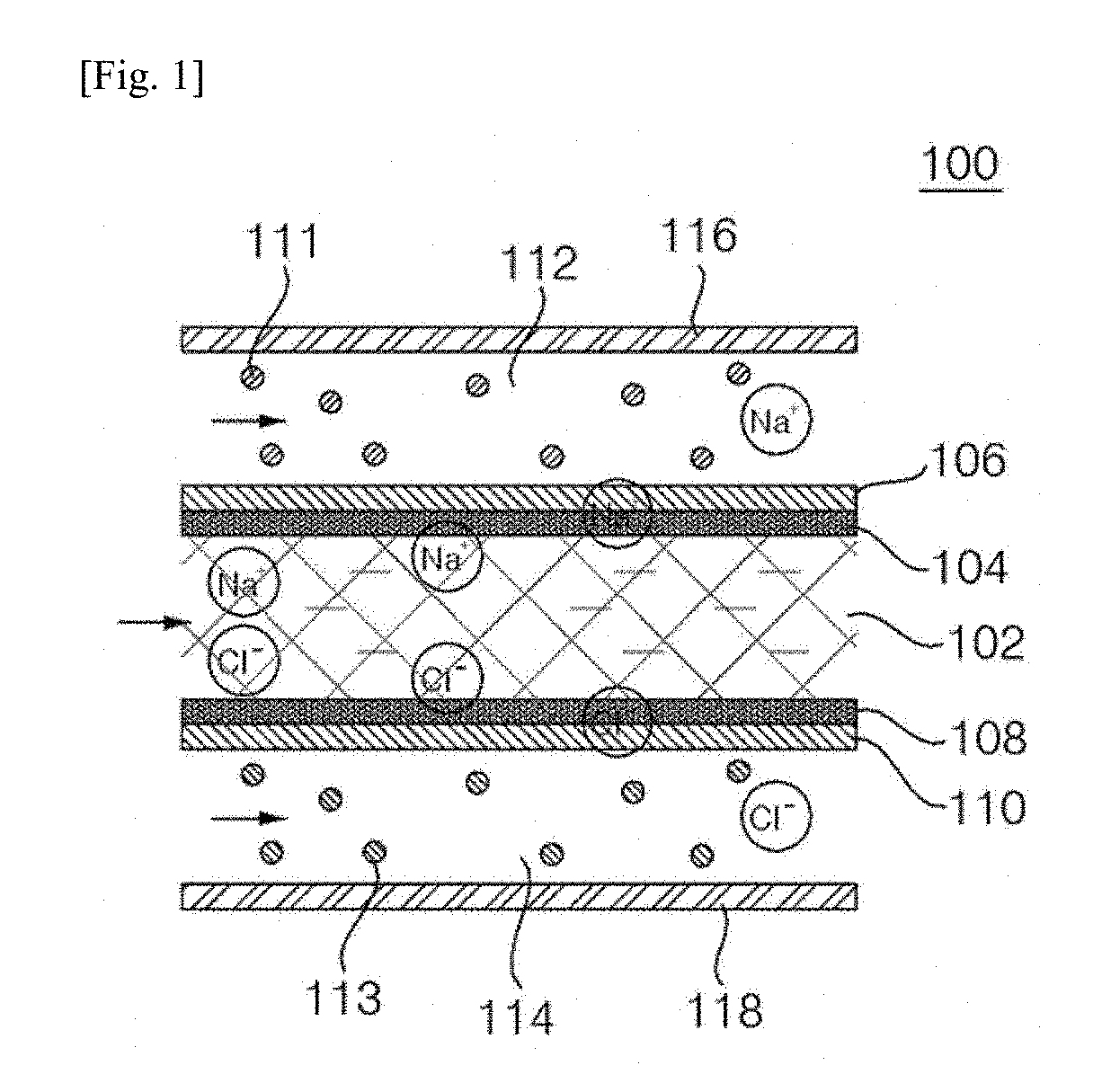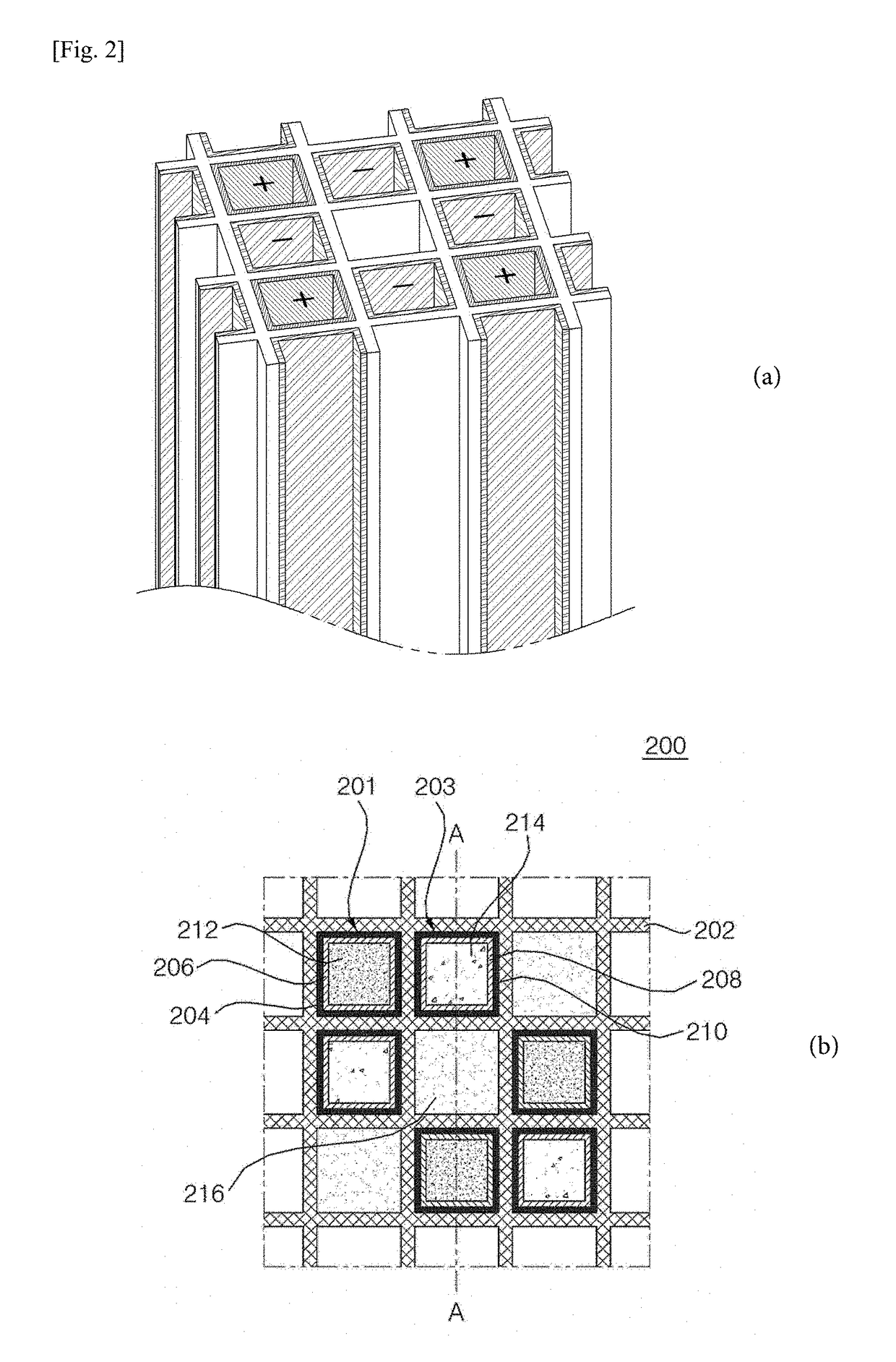Electrochemical cell comprising channel-type flowable electrode units
a flowelectrode unit, channel-type technology, applied in electrochemical methods, electrochemical generators, chemistry apparatuses and processes, etc., can solve the problems of reducing the efficiency of extension capacity, reducing the efficiency of charge-discharge, and high equipment costs, so as to reduce manufacturing costs and installation space
- Summary
- Abstract
- Description
- Claims
- Application Information
AI Technical Summary
Benefits of technology
Problems solved by technology
Method used
Image
Examples
example 1
nnel-Type Flow-Electrode Structures
[0138]A channel-type electrode structure having three channels was manufactured as shown in FIG. 8.
[0139]Specifically, three-square-column-type channel scaffold was molded to prepare a liquid-permeable microporous honeycomb structure. The first square column channel was coated with a positive ion-exchangeable membrane, and the third square column channel was coated with a negative ion-exchangeable membrane. Thus, the positive ion-exchangeable membrane and the negative-exchangeable membrane respectively were formed on an inner wall surface of the channels. Additionally, graphene was coated on the inner wall surfaces of the first square column channel and third square column channel, which had been coated with the ion-exchangeable membranes, to form a porous current collector.
[0140]Therefore, a channel-type flow-electrode structure, in which the first square column channel provides a cathode flow channel along an inside of which a fluid containing a ...
example 2
nel-Type Flow-Electrode Structures
[0144]Nine channel-type flow-electrode structures as shown in FIG. 5a was manufactured in the same manner as in Example 1.
[0145]Additionally, the result of the experiment conducted in the same manner as in Example 1 is shown in Table 1 and FIG. 15.
[0146]The prepared cell was placed in a vessel containing saline solution (35 g / L), and a reaction was initiated. The amount of NaCl in the saline solution can be estimated by measuring the conductivity of the saline solution. In the case of the three-channel type cells, the conductivity of the initial saline solution (35 g / L) without a desalination reaction was 62 mS / cm, but the conductivity thereof after the desalination reaction was decreased to 50 mS / cm. As a result, the concentration of the saline solution was estimated to be 28 g / L, and the salt removal efficiency was 20%. When the cell was expanded to have nine channels, the conductivity was reduced to 8.15 mS / cm; the concentration of the saline sol...
example 3
nt of Desalination Parameters of 1×3 Cell and 3×3 Cell in Batch Mode
[0147]As described in a literature (i.e., A novel three-dimensional desalination system utilizing honeycomb-shaped lattice structures for flow-electrode capacitive deionization, Energy Environ. Sci., 2017, 10, 1746 to 1750), a desalination experiment was conducted in the batch mode of FIG. 17, and the literature above is included in the present invention.
[0148]The dimensions of lattice structures were 3 mm in width, 0.5 mm in wall thickness, and 120 mm in height. The cordierite was used to form porous channels with the size ranging from 10 μm to 30 μm, and an ion-exchangeable membrane was coated on its surface. On the top thereof, about 30 μm of a graphene layer was coated to serve as a conducting current collector. The prepared cell was immersed in the chamber containing saline solution (35 g / L), and then the desalination experiment was conducted in the batch mode. The salt removal efficiency was calculated by the ...
PUM
| Property | Measurement | Unit |
|---|---|---|
| conductivity | aaaaa | aaaaa |
| conductivity | aaaaa | aaaaa |
| concentration | aaaaa | aaaaa |
Abstract
Description
Claims
Application Information
 Login to View More
Login to View More - R&D
- Intellectual Property
- Life Sciences
- Materials
- Tech Scout
- Unparalleled Data Quality
- Higher Quality Content
- 60% Fewer Hallucinations
Browse by: Latest US Patents, China's latest patents, Technical Efficacy Thesaurus, Application Domain, Technology Topic, Popular Technical Reports.
© 2025 PatSnap. All rights reserved.Legal|Privacy policy|Modern Slavery Act Transparency Statement|Sitemap|About US| Contact US: help@patsnap.com



